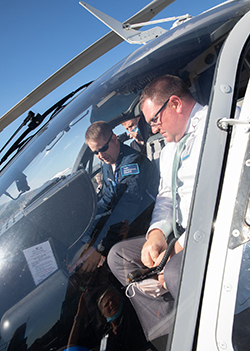-
Services
Featured Specialties
-
Locations
Location Type
-
Patients & Visitors
YNHH’s Emergency Management department recently held a drill with representatives from various hospital departments and community organizations to review the response to an emergency on the hospital’s helipad.
For a hospital, emergency preparedness means being ready and able to handle just about anything – from disease outbreaks to natural disasters – that might bring an influx of patients.
It also means being able to manage events that happen in the hospital itself, such as power failures, fires and cyber attacks – even emergencies on a helipad.

On Sept. 14, Yale New Haven Hospital’s Emergency Management department held a functional drill with hospital and community representatives who might be involved in an emergency with one of the medical helicopters that transports patients to YNHH.
“Helipad emergencies are rare nationwide, but they do happen,” said Jordan Swenson, manager of disaster preparedness and response, YNHH. “Because a fire or other incident on the helipad could also prompt an evacuation of nearby patient care areas, the hospital needs to be ready.”
The helipad drill included staff from YNHH’s Emergency Management, Facilities and Plant Engineering, Protective Services, Pediatric Critical Care Transport and Emergency Department, along with Yale New Haven Health’s SkyHealth emergency transport helicopter. Representatives from the New Haven Fire Department, New Haven Office of Emergency Management, Yale University and Tweed Airport also participated.
During a briefing, they discussed each entity’s role in the event of a medical helicopter’s “hard landing,” fire, crew injury or other situation on YNHH’s helipad. A mechanical issue in flight might prompt the helicopter to divert to Tweed Airport, which has more space and resources to handle these kinds of events.
After the briefing, participants visited the helipad, where a SkyHealth pilot and paramedic provided a hands-on demonstration of pertinent helicopter features and safety protocols.
The helipad drill is one of a number of preparedness exercises Emergency Management is required to hold each year, Swenson said.
“Our job is to ensure the hospital is ready for a wide variety of worst-case scenarios, no matter where they occur, or what they involve.”
Watch a video of the helipad drill >